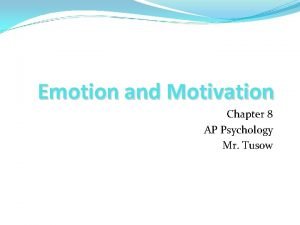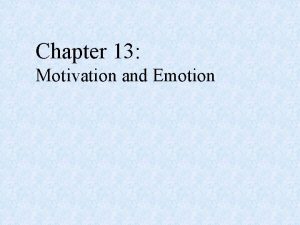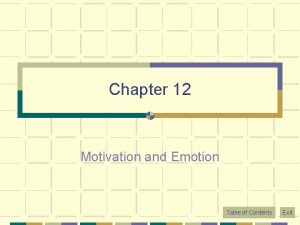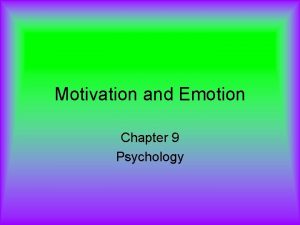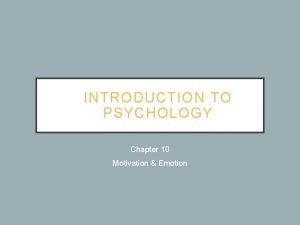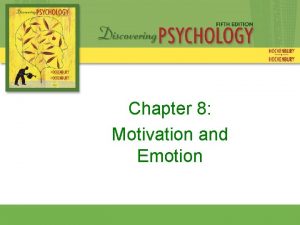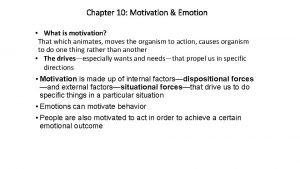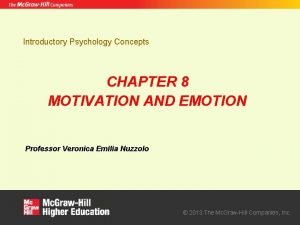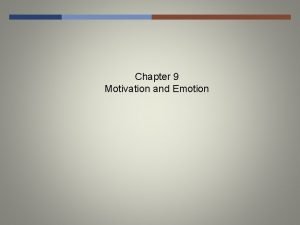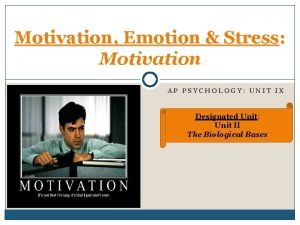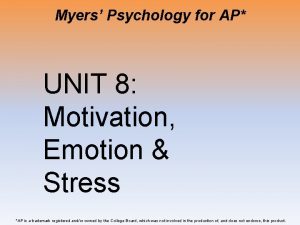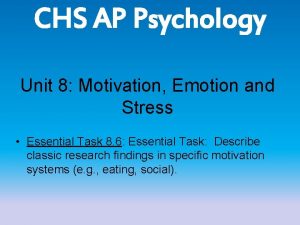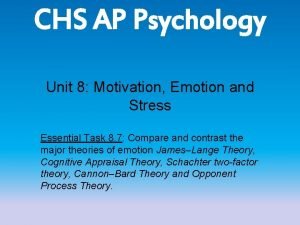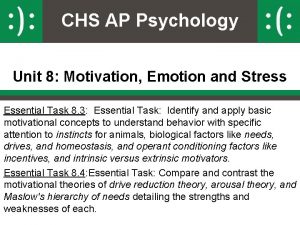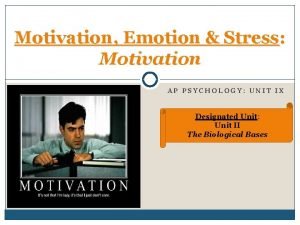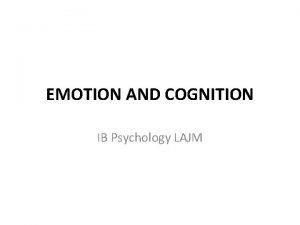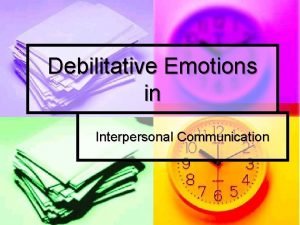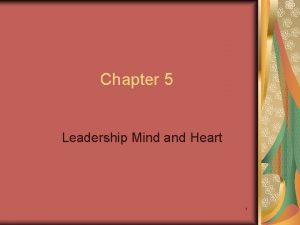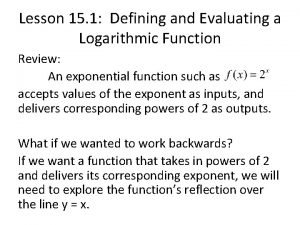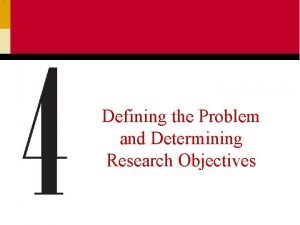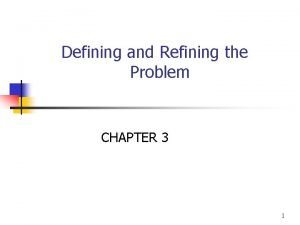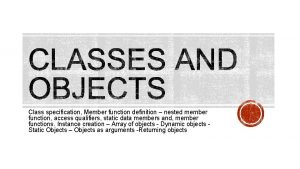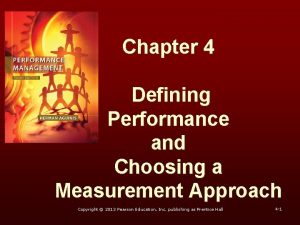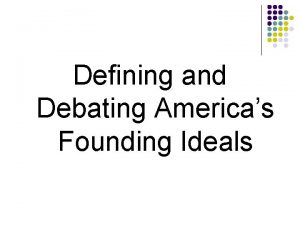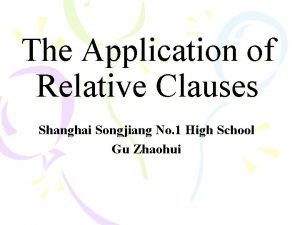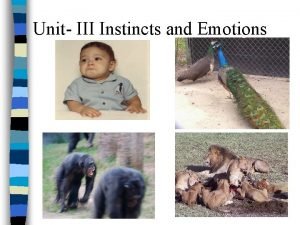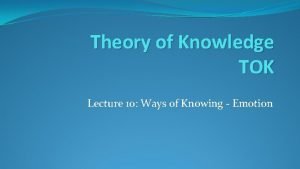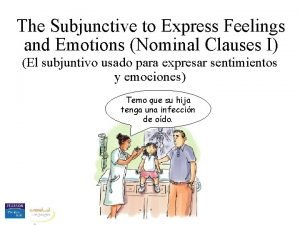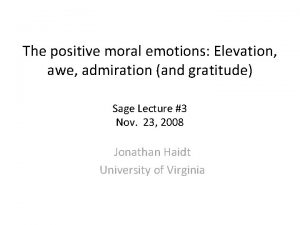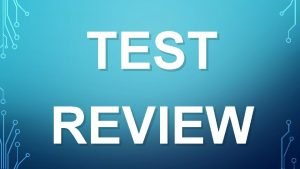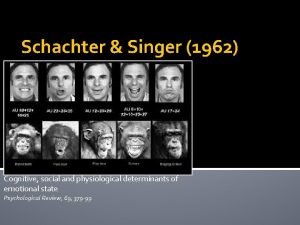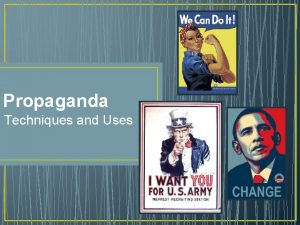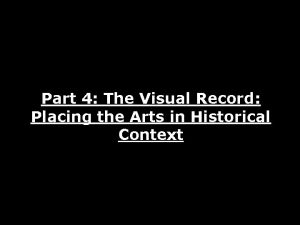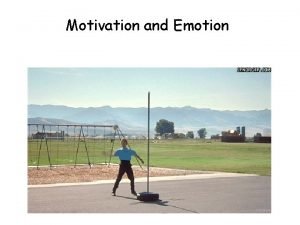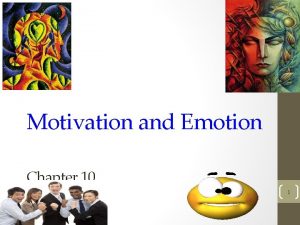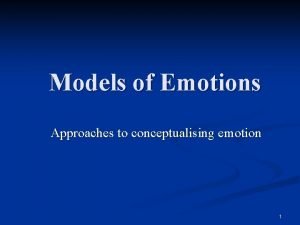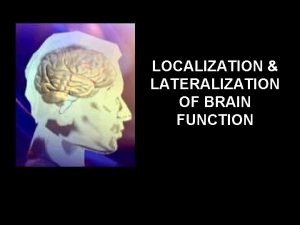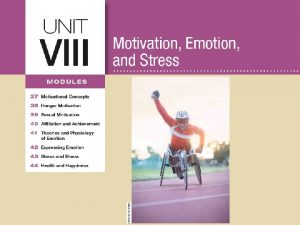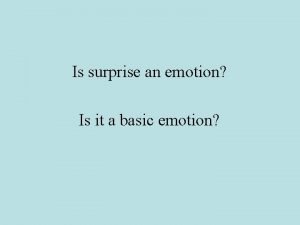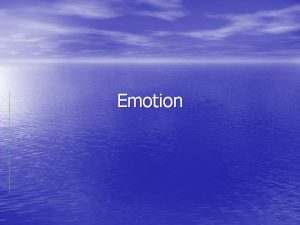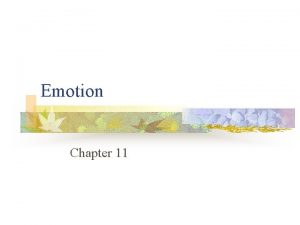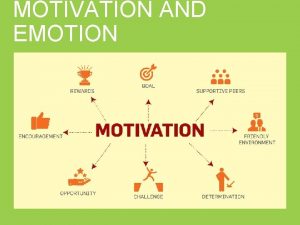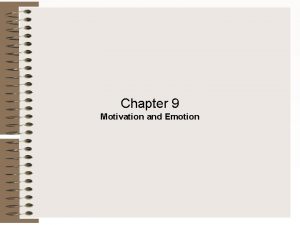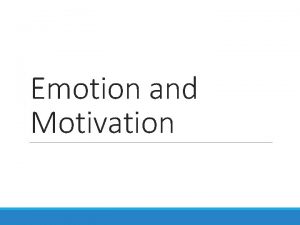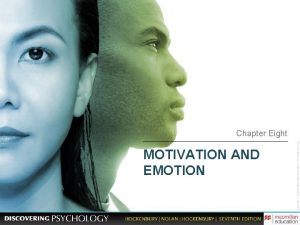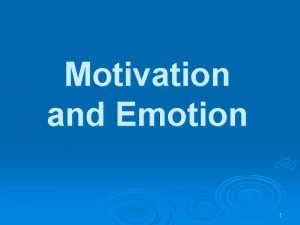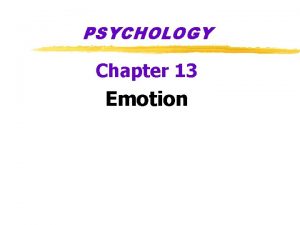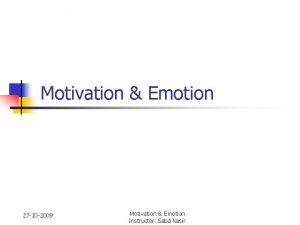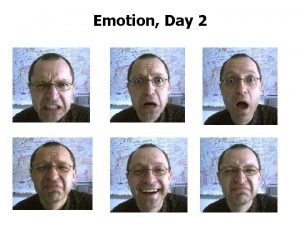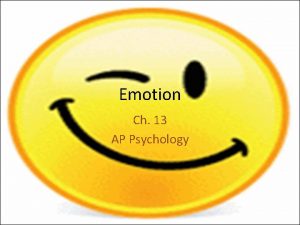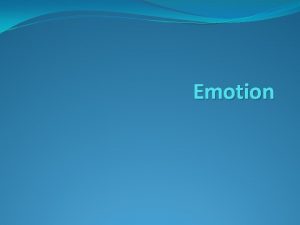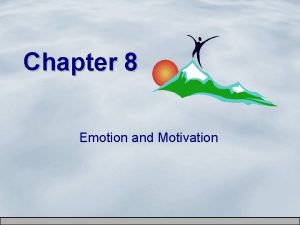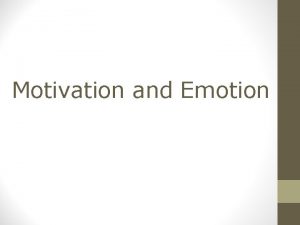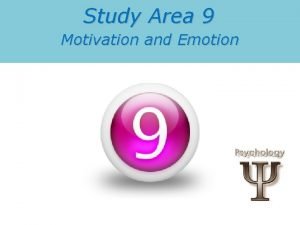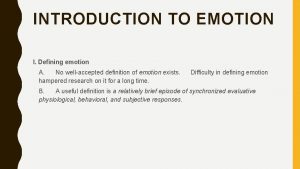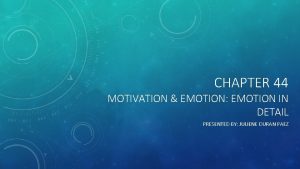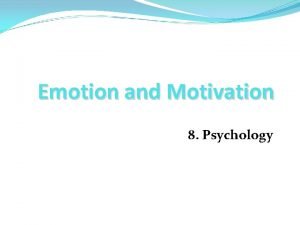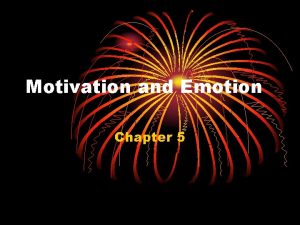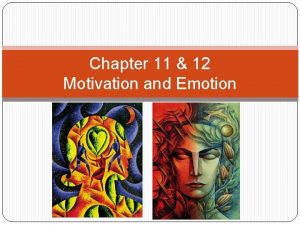Chapter 10 Motivation and Emotion Defining Motivation and
















































- Slides: 48

Chapter 10 Motivation and Emotion

Defining Motivation, and a Model • Dynamics of behavior that initiate, sustain, direct, and terminate actions • Model of motivation – Need: Internal deficiency; causes drive – Drive: Energized motivational state (e. g. , hunger, thirst); activates a response – Response: Action or series of actions designed to attain a goal – Goal: Target of motivated behavior

Incentive Value • Goal’s appeal beyond its ability to fill a need

Types of Motives • Biological motive: Innate (inborn) motives based on biological needs that must be met to survive e. g. , hunger, thirst • Stimulus motive: Needs for stimulation and information; appear to be innate, but not necessary for survival • Learned motive: Based on learned needs, drives, and goals e. g. , blogging

Homeostasis • Steady state of body equilibrium; balance

Circadian Rhythms • Cyclical changes in bodily functions and arousal levels that vary on a schedule approximating a 24 -hour day • Pre-adaptation: Gradual matching of sleepwaking cycles to a new time schedule before an anticipated circadian rhythm change – e. g. , trying to adjust to new time zone to avoid jet lag • Melatonin: Hormone produced by pineal gland in response to light (production suppressed) and dark (production increased)

Jet Lag • Disturbed body rhythms caused by rapid travel east or west • Major time shifts (5 hours or more) can cause very slow adaptation • Direction of travel affects adaptation, and thus, severity of jet lag – Much easier to go east to west than west to east

Hunger • Hypoglycemia: Low blood sugar • Hypothalamus: Brain structure; regulates many aspects of motivation and emotion, including hunger, thirst, and sexual behavior • Feeding system: Area in the lateral hypothalamus that, when stimulated, initiates eating • Satiety system: Area in the ventromedial hypothalamus that terminates eating

Paraventricular Nucleus • Located in the hypothalamus; keeps blood sugar levels steady by starting and stopping eating

More on Eating Behavior • Neuropeptide Y (NPY): Substance in the brain that initiates eating; works on paraventricular nucleus in hypothalamus • Glucagon-like peptide 1 (GLP-1): Substance in brain that terminates eating • Set point: Proportion of body fat that is maintained by changes in hunger and eating; point where weight stays the same when you make no effort to gain or lose weight

The Final Word on Eating Behavior • Leptin: Substance released by fat cells that inhibits eating • External eating cues: Signs and signals linked with food

Taste • Taste aversion: Active dislike for a particular food – VERY difficult to overcome • Bait shyness: Unwillingness or hesitation by animals to eat a particular food

Behavioral Dieting • Weight reduction based on changing exercise and eating habits and not on temporary selfstarvation • Some keys – Start with a complete physical – Exercise – Be committed to weight loss

Behavioral Dieting (cont) • Observe yourself, keep an eating diary, and keep a chart of daily progress • Eat based on hunger, not on taste or learned habits that tell you to always clean your plate • Avoid snacks • Learn to weaken personal eating cues

Eating Disorders: Anorexia Nervosa • Active self-starvation or sustained loss of appetite that seems to have psychological origins – Control issues seem to be involved – Very difficult to effectively treat – Overwhelmingly affects adolescent females • About 10% are male

Eating Disorders: Bulimia Nervosa • Excessive eating (gorging) usually followed by self-induced vomiting and/or taking laxatives – Difficult to treat – Prozac and Zoloft approved by FDA to treat bulimia nervosa • Affects more females than males – About 25% are male

Causes of Anorexia Nervosa and Bulimia Nervosa • Anorexics and bulimics have exaggerated fears of becoming fat; they think they are fat when the opposite is true • Bulimics are obsessed with food and weight; anorectics with perfect control • Anorexics will often be put on a “weight-gain” diet to restore weight • Treat with cognitive-behavioral techniques

Thirst • Extracellular thirst: When water is lost from fluids surrounding the cells of the body • Intracellular thirst: When fluid is drawn out of cells because of increased concentration of salts and minerals outside the cell – Best satisfied by drinking water

Pain Avoidance • An episodic drive • Occurs in distinct episodes when bodily damage takes place or is about to occur

Sex Drive • Sex drive: Strength of one’s motivation to engage in sexual behavior • Estrus: Changes in sex drives in animals, which creates a desire for sex; females in heat • Estrogen: A female sex hormone • Androgens: Male hormones • Non-homeostatic drive: Independent of bodily need states or physical deprivation cycles

Stimulus Drives • Reflect needs for information, exploration, manipulation, and sensory input • Arousal: Activation of the body and nervous system

Yerkes-Dodson Law • If a task is simple, it is best for arousal to be high; if it is complex, lower levels of arousal provide for the best performance • Arousal theory: Assumes people prefer to maintain ideal, or comfortable, levels of arousal • Sensation seeking: Trait of people who prefer high levels of stimulation

Test Anxiety • High levels of arousal and worry that seriously impair test performance

How to Cope With Test Anxiety • • Preparation Relaxation Rehearsal Restructuring thoughts

Learned Motives • Opponent-process theory: Strong emotions tend to be followed by an opposite emotional state; strength of both emotional states changes over time • Social motives: Acquired by growing up in a particular society or culture

Some Needs • Need for achievement (n. Ach): Desire to meet some internal standard of excellence • Need for power: Desire to have social impact or control over others

Abraham Maslow and Needs • Hierarchy of human heeds: Maslow’s ordering of needs based on presumed strength or potency; some needs are more powerful than others and thus will influence your behavior to a greater degree

Maslow’s Needs • Basic needs: First four levels of needs in Maslow’s hierarchy – Lower needs tend to be more potent than higher needs • Love and belonging • Need for esteem and self-esteem • Growth needs: Higher-level needs associated with self-actualization • Meta-needs: Needs associated with impulses for self-actualization

Types of Motivation • Intrinsic motivation: Motivation coming from within, not from external rewards; based on personal enjoyment of a task or activity • Extrinsic motivation: Based on obvious external rewards, obligations, or similar factors

Emotions • State characterized by physiological arousal and changes in facial expressions, gestures, posture, and subjective feelings • Adaptive behaviors: Aid our attempts to survive and adjust to changing conditions • Physiological changes (in emotions): Include heart rate, blood pressure, perspiration, and other involuntary responses

More on Emotions • Adrenaline: Hormone produced by adrenal glands that arouses the body • Emotional expression: Outward signs of what a person is feeling • Emotional feelings: Private emotional experience

Primary Emotions and Mood (Plutchik, 2003) • Eight primary emotions – Fear – Anger – Surprise – Anticipation – Sadness – Joy – Disgust – Trust

Primary Emotions and Mood (cont) • Mood: Low-intensity, long-lasting emotional state

Brain and Emotion • Amygdala: Part of limbic system that produces fear responses

Autonomic Nervous System (ANS) • Neural system that connects brain with internal organs and glands – Activity’s automatic, not voluntary • Sympathetic branch: Part of ANS that activates body for emergency action • Parasympathetic branch: Part of ANS that quiets body and conserves energy – Parasympathetic rebound: Overreaction to intense emotion

Lie Detectors • Polygraph: Device that records changes in heart rate, blood pressure, respiration, and galvanic skin response (GSR); lie detector • GSR: Measures sweating

Questions Asked While Taking a Polygraph • Irrelevant questions: Neutral, nonthreatening, non-emotional questions in a polygraph test • Relevant questions: Questions to which only someone guilty should react • Control questions: Questions that almost always provoke anxiety in a polygraph (e. g. “Have you ever taken any office supplies? ”)

Body Language (Kinesics) • Study of communication through body movement, posture, hand gestures, and facial expressions • Facial blends: Mix of two or more basic expressions

Three Basic Dimensions of Facial Expressions • Pleasantness–unpleasantness • Attention–rejection • Activation: Degree of arousal a person is experiencing

Chameleon Effect • Unconsciously imitating the postures, mannerisms, and facial expressions of others as we interact with them

Detecting Lies • Illustrators: Gestures people use to illustrate what they are saying – Tend to decrease when person is lying • Emblems: Gestures that have widely understood meanings within a particular culture – Tend to increase when person is lying

Theories of Emotion

James-Lange Theory • Emotional feelings follow bodily arousal and come from awareness of such arousal

Cannon-Bard Theory • Activity in the thalamus (in brain) causes emotional feelings and bodily arousal at the same time

Schachter’s Cognitive Theory • Emotions occur when physical arousal is labeled or interpreted on the basis of experience and situational cues

Attribution • Mental process of assigning causes to events; attributing arousal to a certain source

Facial Feedback Hypothesis • Sensations from facial expressions help define what emotion a person feels

A Modern View of Emotion • Emotional appraisal: Evaluating personal meaning of a stimulus or situation • Emotional intelligence: Ability to perceive, use, understand, and manage emotions
 Relative pronouns defining and non-defining
Relative pronouns defining and non-defining Relative clauses defining and non defining
Relative clauses defining and non defining Relative pronouns defining and non-defining
Relative pronouns defining and non-defining Defining and non defining relative clauses in telugu
Defining and non defining relative clauses in telugu Defining and non-defining relative clause
Defining and non-defining relative clause Defining and non-defining relative clauses arasındaki fark
Defining and non-defining relative clauses arasındaki fark Over justification affect
Over justification affect Chapter 13 motivation and emotion
Chapter 13 motivation and emotion Chapter 12 motivation and emotion
Chapter 12 motivation and emotion Intrinsic and extrinsic motivation
Intrinsic and extrinsic motivation Paul ekman universal facial expressions
Paul ekman universal facial expressions Cognitive appraisal
Cognitive appraisal Chapter 10 motivation and emotion
Chapter 10 motivation and emotion Chapter 8 motivation and emotion
Chapter 8 motivation and emotion Psychology chapter 9 motivation and emotion
Psychology chapter 9 motivation and emotion Chapter 9 motivation and emotion quiz
Chapter 9 motivation and emotion quiz William masters ap psychology
William masters ap psychology Unit 8 myers ap psychology
Unit 8 myers ap psychology Unit 8 motivation and emotion
Unit 8 motivation and emotion Two factor theory psychology
Two factor theory psychology Homeostasis ap psychology
Homeostasis ap psychology Unit 8 motivation and emotion
Unit 8 motivation and emotion Yerkes dodson law ap psychology example
Yerkes dodson law ap psychology example Emotion and cognition ib psychology
Emotion and cognition ib psychology Cognitive interpretation interpersonal communication
Cognitive interpretation interpersonal communication Leadership mind and emotion
Leadership mind and emotion 15.1 defining and evaluating a logarithmic function answers
15.1 defining and evaluating a logarithmic function answers Defining the problem and research objectives
Defining the problem and research objectives Approaches to measuring performance
Approaches to measuring performance Exploratory research example
Exploratory research example Nesting of member function in c++
Nesting of member function in c++ Approaches to measuring performance
Approaches to measuring performance Discovering american ideals in primary sources
Discovering american ideals in primary sources Defending and non defining relative clauses
Defending and non defining relative clauses Characteristics of emotions ppt
Characteristics of emotions ppt Tok ways of knowing
Tok ways of knowing William james theory
William james theory Padecer present subjunctive
Padecer present subjunctive Subway hero
Subway hero Which of the following best describes task performance?
Which of the following best describes task performance? Schachter and singer sample
Schachter and singer sample Propagandadefinition
Propagandadefinition Narmer palette meaning
Narmer palette meaning Which of the following factors stimulate us to eat?
Which of the following factors stimulate us to eat? Function of emotions
Function of emotions Circumplex model of emotion
Circumplex model of emotion Lateralization of emotion
Lateralization of emotion James lange theory of emotion vs schachter singer
James lange theory of emotion vs schachter singer Is surprise an emotion
Is surprise an emotion






